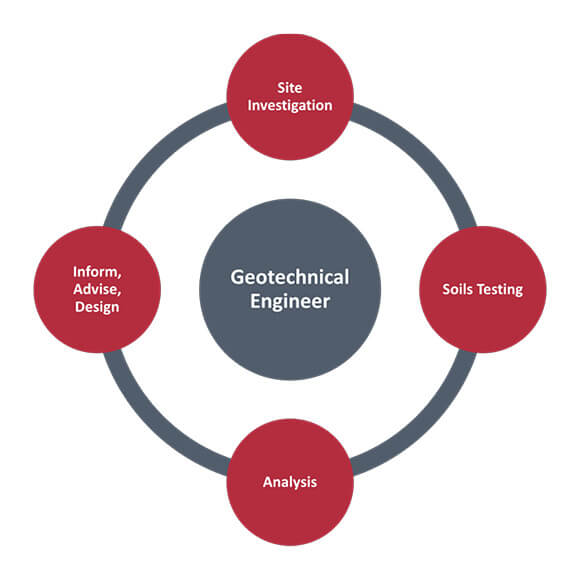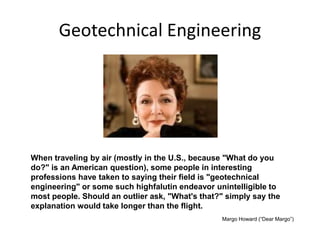An Unbiased View of Geotheta
An Unbiased View of Geotheta
Blog Article
Geotheta for Beginners
Table of ContentsThe Geotheta PDFsGeotheta for BeginnersThe 20-Second Trick For GeothetaWhat Does Geotheta Mean?
They team up with civil designers, architectural designers, designers, and other professionals to integrate geotechnical considerations into the overall task layout and building and construction process. This requires efficient team effort, sychronisation, and communication to make sure that the geotechnical elements align with the project objectives and meet governing needs.Mining & Materials Engineering: Principles of boring, penetration rates, and variables impacting the selection of exploration technique. Blasting methods in surface and below ground functions. Mechanical and continuous techniques to fragmentation, including longwall shearing and fullface boring.
Modelling of piece and particle dimension circulations; comminution as a transfer feature. Comminution innovation: squashing, grinding, dimension classification. Integrated evaluation of fragmentation and comminution operations. Supplied by: Mining & Materials Design.
Indicators on Geotheta You Need To Know
Bachelor's level programs in civil, geotechnical, geological, and environmental engineering generally last four years and consist of basic education training courses in English, social scientific research, and the liberal arts, in addition to training courses in innovative maths, architectural geology, and liquid mineralogy. (https://geotheta.blog.ss-blog.jp/2024-08-02?1722614750)
Geotechnical engineering involves the evaluation of the dirt and rock problems at a particular website, and their effects for the advancement of that site. As the majority of structures count on the ground for assistance, it lacks surprise that a comprehensive understanding of the ground problems, and the viability of structure systems, are vital to the long-lasting security and performance of the structure or framework.
Being experts in the examination of geological developments and ground behaviour, geotechnical designers perform scientific examinations and screening to comprehend the effect these geological formations might have on the design and construction of building, civil and infrastructure jobs. This competence is critical for the design and construction of buildings, roadways, passages, dams, bridges, and water supply and sewer systems.
The geotechnical group at Douglas Partners regularly consult with designers, style designers, programmers, and home builders to make referrals on layout and growth propositions to guarantee that the developed structures are appropriately made for the ground problems. For instance, the layout of footing systems requires to think about the weight of the structure, the ability of the ground to support that weight along with activity resistances and effective building and construction.
Geotheta Can Be Fun For Everyone
This task is substantially simplified by the use our Douglas Map geospatial system which makes this info easily accessible in a very easy to utilize internet browser interface. A geotechnical engineer will certainly direct the exploration of boreholes and test pits to gather dirt and various other samples, and additionally examine surface functions and ground direct exposures to develop a geotechnical model of the subsurface conditions.
Relying on the task type and ground problems encountered, research laboratory testing might among other points assess strength, compressibility, sensitivity and/or permeability of dirt and rock samples. Hereafter information is collected and looked at, the outcomes are made use of for a geotechnical model of the website, which is usually offered as sections throughout the website.

A geotechnical investigation by nature can only evaluate the ground problems at the areas pierced or excavated. Natural variants in dirt and rock problems can occur across a site and in between examination areas. It is for that reason excellent technique that the geotechnical designer be retained throughout building of the job to supply on-site verification that the ground conditions come across follow the expectations and guidance supplied in the geotechnical examination record.
Things about Geotheta
Geotechnical designers use their thorough understanding of soil and rock to examine danger and resolve problems on diverse facilities projectsGeotechnical engineering is a specialist branch of civil engineering which looks at the behavior of earth products and the application of dirt and rock technicians. Engineer of Record. As a geotechnical designer, you will analyze the physical, mechanical and chemical buildings of soil and rock in order to develop foundations, preserving structures and click to investigate earthworks
Geotechnical engineering is very closely linked to and overlaps with, both design geology and ground engineering - https://disqus.com/by/geotheta/about/. It's possible to be experts in geotechnics or job for a geotechnical business but be known as an engineering geologist or a ground engineer. As a geotechnical engineer, you'll need to: construct and keep partnerships with customers and various other experts associated with the site, throughout each projectmaintain safety and security requirements on site bear in mind expense effects when you make recommendationsstudy geological maps and airborne photographs from a variety of sources and from various time periodsexamine building and construction prepares to see how possible they are based on your understanding of the siteinvestigate dangers or geological threats for the sitesearch for environmentally delicate functions, such as landfill start to develop factual and interpretive ground modelsplan field investigationsdrill and evaluate samples of bedrock, soil, groundwater and added materials supervise other professionals on sitesolve technological concerns as they emerge, such as unanticipated frameworks at drill sitesmonitor problems during and after construction to make certain structures are stable in the brief and lengthy termadding data gathered on website to your initial researchcreating geotechnical estimations, drawings, and two or three-dimensional computer versions analyzing the datamaking suggestions about the suggested use the website

Report this page